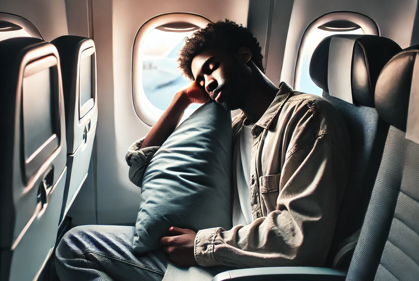
How to go back to sleep after waking up at night
Some strategies such as breathing exercises may help you fall back asleep
The low pressure and air quality make it hard to relax, while turbulence disrupts any chance of rest.
In Summary

There is nothing worse than wanting to sleep, but being unable to during a flight. Imagine you are scrolling down the list of films to watch but your mind is already set to sleeping.
This is however proving difficult taking into consideration that there are cramped spaces, people chewing loudly, babies crying, and uncomfortable seating.
The low pressure and air quality also make it hard to relax, while nearby passengers and turbulence disrupt any chance of rest.
Let’s delve into how you can make the environment comfortable enough for you to sleep.
Use noise-cancelling devices
A plane cruising level generates 85 decibels (dBA) which is not good for the ears and by extension, not soothing enough for sleep.
According to the American Speech–Language–Hearing Association, sounds at 85 dBA can lead to hearing loss if you listen to them for more than eight hours at a time.
To deal with this and get some sleep, you can use cancelling headphones or earplugs to block out excess noise from the plane and the disrupting passengers.
Wear light-blocking eye masks
Natural light can also delay your sleep by shortening melatonin duration
To be able to sleep during a flight, it is advisable to dim the lights as much as possible and wear a mask to block out light.
Pick the right seat and sleeping position
According to National Geographic, you can invest in the correct pillows for the neck, head and tailbone. To sleep better, you should support your head and neck.
Do not use the drop-down tray table as a headrest.
You should choose a seat far from the labs and if possible, avoid the aisle or the middle seats.
Try to lean backwards as allowed when flying in different classes.
Try medication and sleep aids
In the case that you have aviophobia or fear of flying, you can ask your doctor to prescribe anti-anxiety pills like Xanax and Ambien.
You can also use melatonin medication – used to promote sleep and is safe for short-term use. It is advisable to use melatonin for trips longer than six hours, to avoid landing to your destination while groggy.
Wear socks
You should have a blanket with you. Besides this, however, ensure you wear bed or flight socks.
A study in the Journal of Physiological Anthropology found that feet-warming socks led to 7.6 per cent higher sleep efficiency, 7.5 times fewer sleep awakenings and 32 more minutes of sleep among the participants.
Use footsteps
When in a plane, place both your legs straight and put a slight bend in your knees. You should also ensure to keep personal items and bags out of the under-seat area, allowing you room to stretch and provide circulation to your feet.
Avoid alcohol and caffeine
While it can initially lull you into slumber, studies show that alcohol can lead to more awakenings, worse sleep quality and less deep sleep.
Plus, you will wake up feeling dehydrated and groggy, amplifying the dreaded jet lag.
One should also avoid caffeine as it can make it more difficult to get rest during the flight, potentially leading to increased fatigue upon arrival.

Some strategies such as breathing exercises may help you fall back asleep